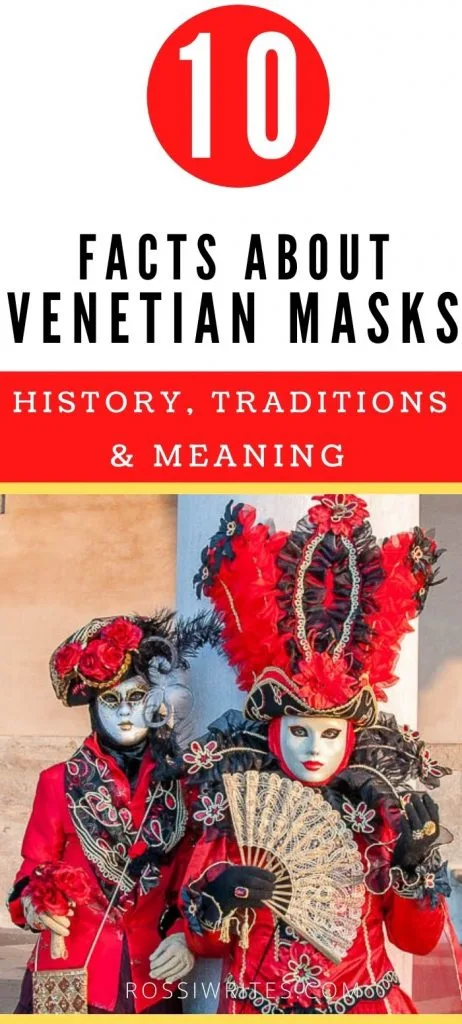Here are ten facts about Venetian masks and their history, traditions, and meaning.
Everywhere you look in Venice, Italy you will see beautiful handmade masks.
They catch your eye from the lavish displays of artisan mask-making shops. They peek at you from frescoes and paintings by famous Venetian artists. They adorn the walls of hotels and private homes. Then – during the famous Carnival of Venice – masks are worn by extravagantly masqueraded people all over the city on water.
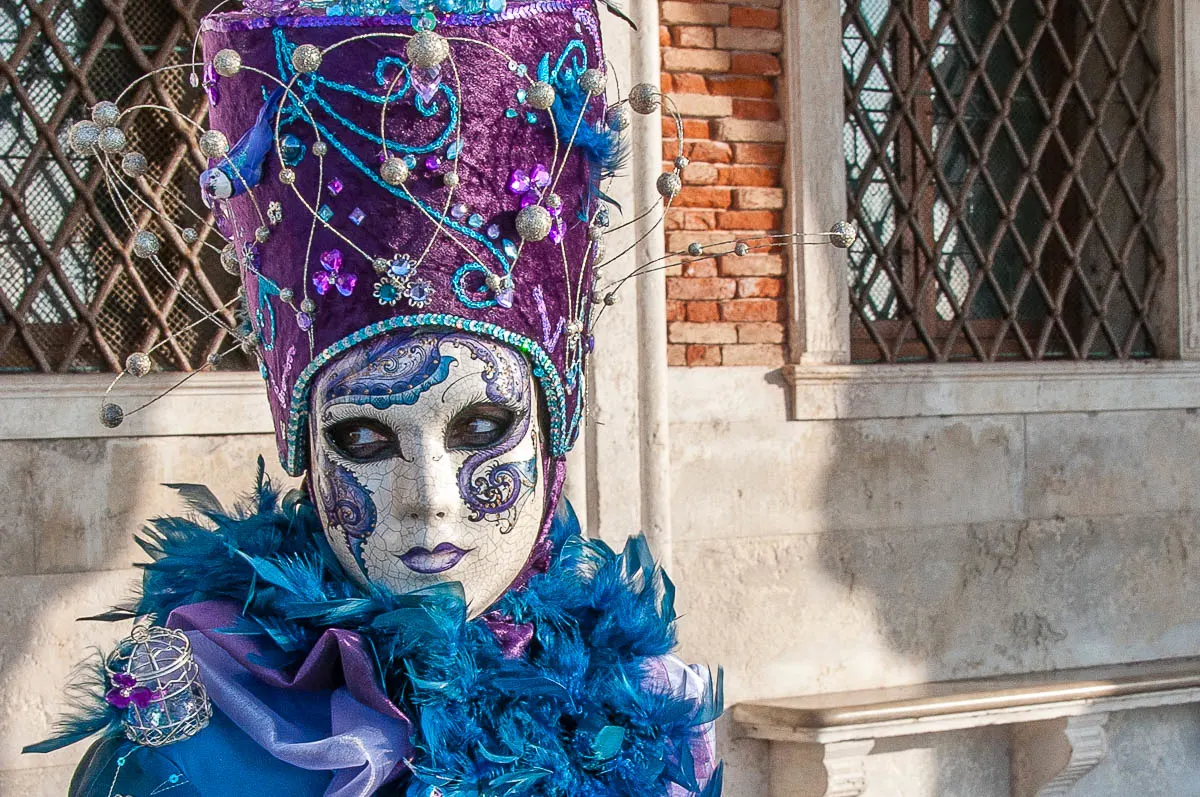
Venetian masks are beautiful! They also have a long history and rich traditions behind them.
Made of paper mache, velvet, and lace, decorated with feathers, rhinestones, gold and silver leaf, they are veritable works of wearable art. With their whimsical designs and promise of mystery, Venetian masks appeal to your sense of drama and quickly seduce you.
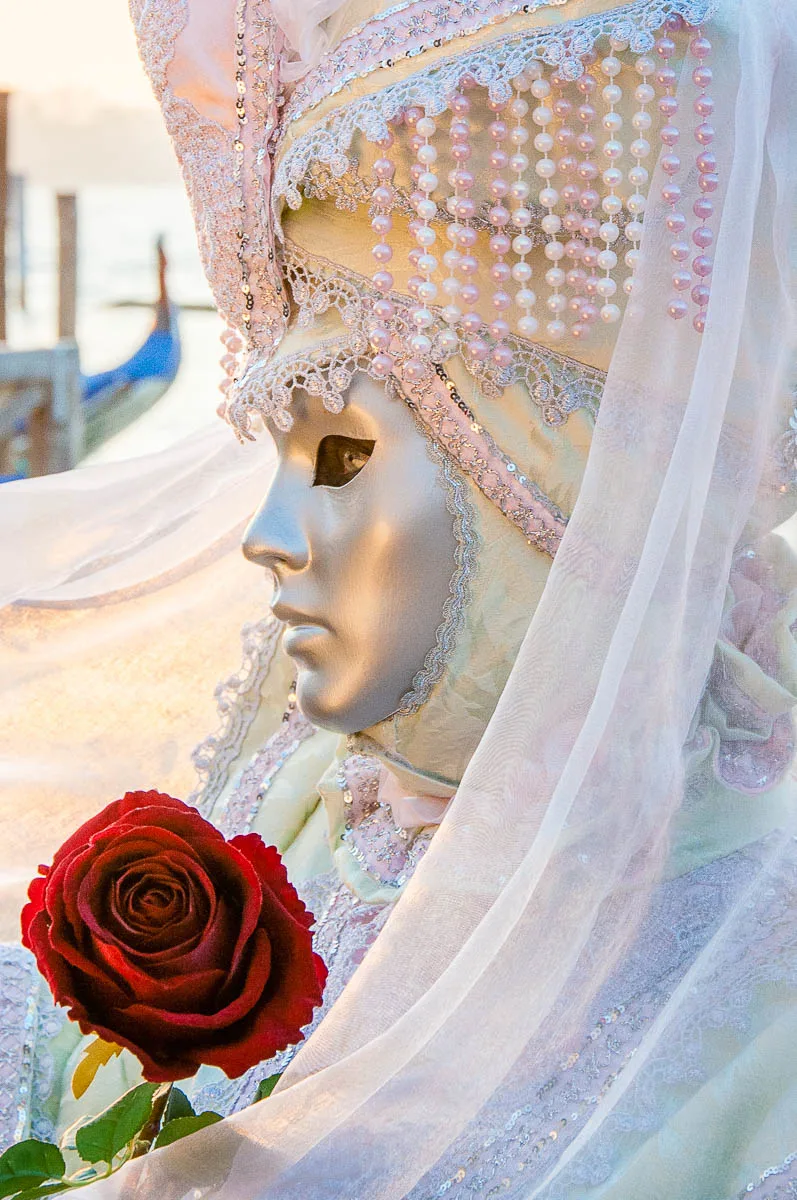
It is impossible to resist the allure of Venetian masks!
Before you know it, you start making plans about buying at least one to take home with you as a wonderful memento of your time in Venice, Italy. ‘It will look great on the wall!’, you reason with yourself. ‘And you never know! I may get invited to a masquerade one day!’
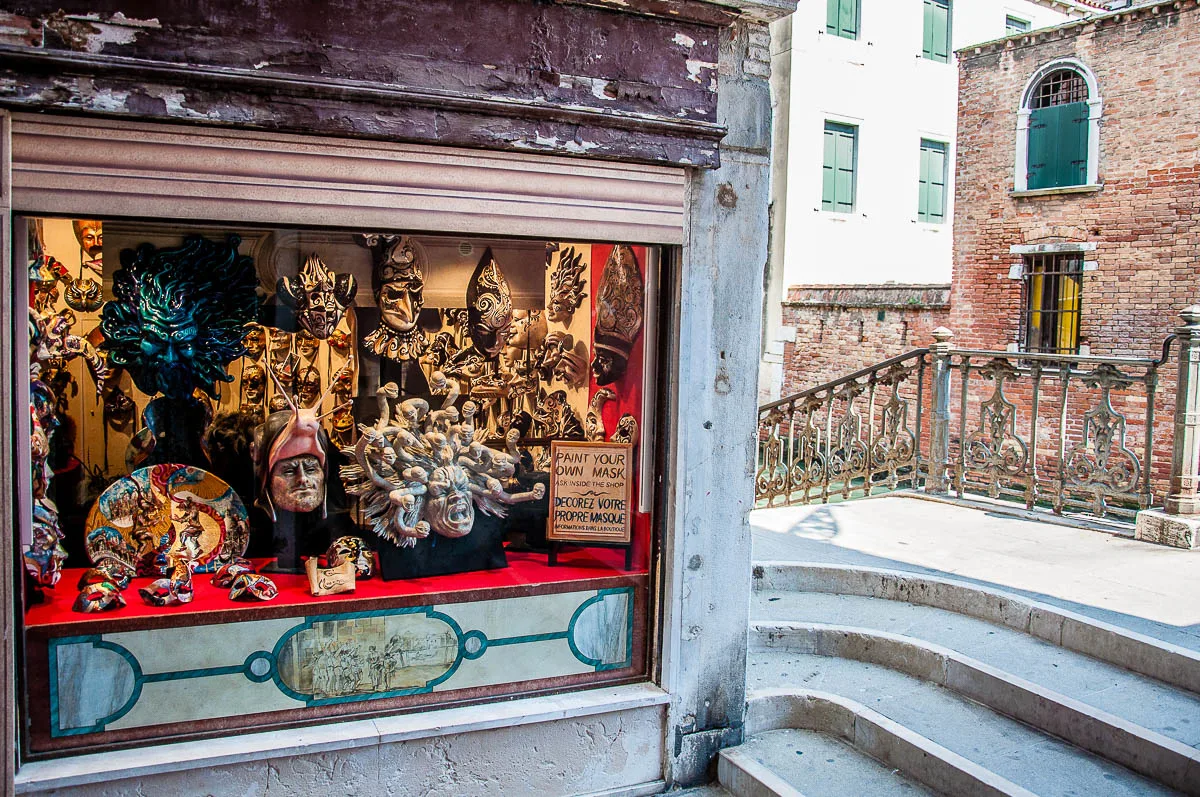
By all means, go ahead and buy at least one Venetian mask during your stay in Venice. And let it be the most extravagant and beautiful one that you can manage. In the years that will come, you will often stop to look at it – hanging on your wall or lovingly displayed on a shelf with other personal treasures. With its whimsical shape and lavish decoration, your Venetian mask will add a bit of sparkle even to the greyest day.
Now, before you take your card out to pay for your Venetian mask, let me share with you ten facts about masks in Venice. From a short historic overview of why and when the Venetians started to wear masks to what each Venetian Carnival mask represents, this blog post gives you many curious and useful details. I have also included lots of simple, insider tips so that you know how to pick a truly authentic mask by an artisan maker in Venice.
Mask-making and mask-wearing are centuries-old traditions in Venice, Italy. Knowing a bit about the history behind them and the work that goes into creating the different types of masks will help you appreciate them better. It will inform your purchasing decisions, too. Understanding what each mask means and how to best take care of it, will allow you to enjoy your Venetian mask for as long as possible.
I have organised these ten facts about Venetian masks in concise and entertaining chunks of information. I hope that you will find it all very engaging and enriching to read. And that it will inspire you to delve deeper into the world of masks in Venice so as to find the one that truly appeals to you and makes you feel so very mysterious and special.
Have a look!
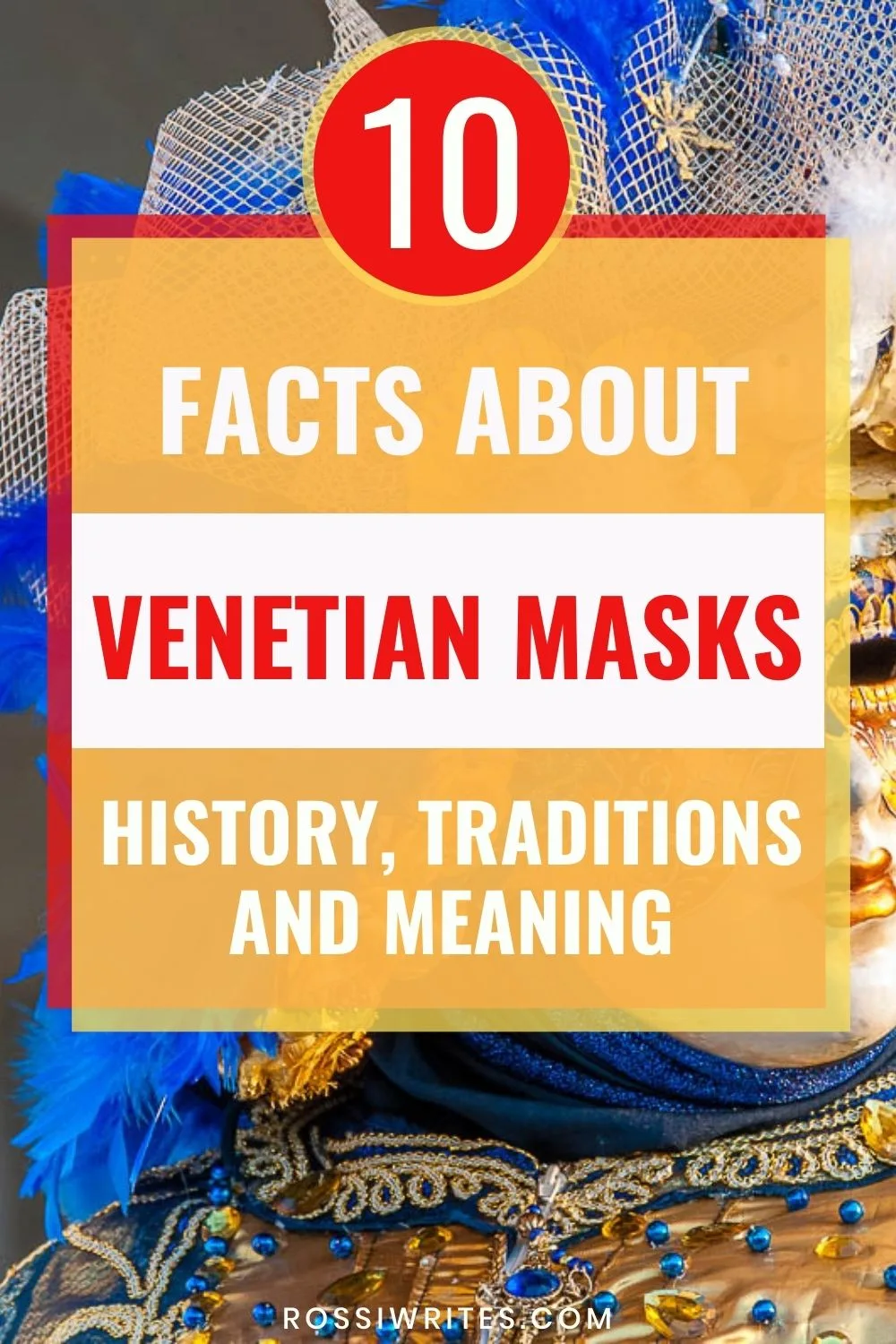
10 Facts about Venetian Masks – History, Traditions, and Meaning
1. Masks Have Been Worn in Venice since the Middle Ages
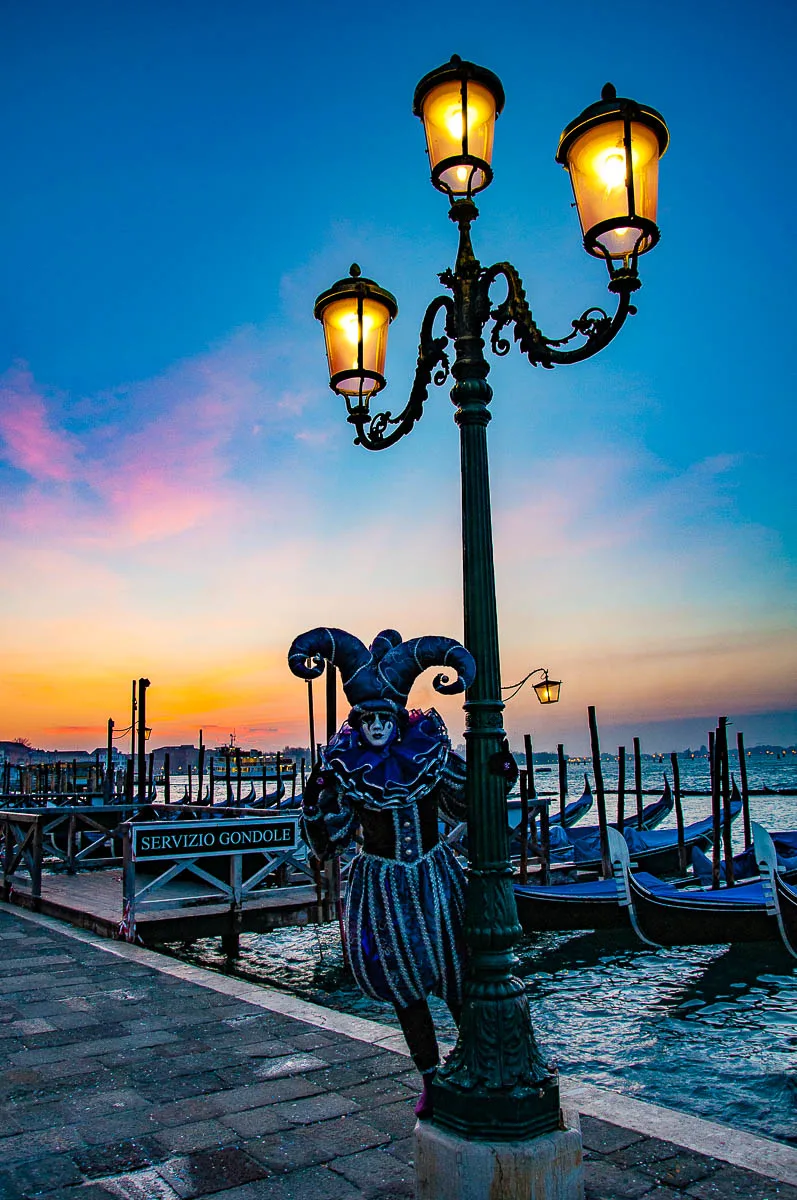
Masks and Venice go together centuries back in time. While nowadays, masks are one of the most popular and sought-after souvenirs one can buy in Venice, in the past wearing a mask here was very much a way of life.
As a social equaliser, the Venetian masks allowed rich and poor Venetians to mingle together and to avoid scrutiny. Venetian ladies employed them as much to preserve their modesty as to play seduction games.
While masks started life in Venice as an accessory to the city’s lavish Carnival, soon they transcended the Carnival period and were worn in the city on water for most of the year.
The documented story of the Venetian Carnival starts in 1094. This is when Doge Vitale Falier signed the first document that has reached us where the precursor of the word Carnival – carnis laxatio – is mentioned.
Originally the Carnival of Venice started on St. Stephen’s Day on 26th December and lasted until Shrove Tuesday. It was a period of the year when the Ancient Roman spirit of panem et circenses was truly alive. Plus, the different classes of the strict Venetian society could mix and be merry together behind the anonymity allowed by a mask.
The advantages of wearing a mask soon caught on. By the 13th century, there were several mask makers and hundreds of mask wearers in Venice. In fact, the first mention of masks in Venetian laws dates back to this century.
At the time, a favourite Venetian pastime was to throw perfume-filled eggshells at passers-by. However, people felt emboldened by the anonymity granted by masks and started throwing eggs filled with ink instead of rose water. This soon became a public hazard and the Venetian Senate had to step in. Hence, in 1268 a law was passed forbidding those concealed by a mask to throw eggshells.
By the 13th century, the Venetian mask makers were already organised in a guild. Known as the Arte dei Depentori, this was the guild of those working with paint. Among them were also the painters, gilders, textile designers, embroiderers, gold-tooled leather artisans, playing-card makers, and sign makers of Venice.
In 1271, the first statute of the Arte dei Depentori came into force. It is the oldest statute relating to the craft of painting in Italy. From this point onwards, the production of masks in Venice grew, new mask-making workshops were established, and different mask-making techniques were developed and applied in practice. Mask makers were known as mascareri in the Venetian language. Their work was officially recognised as a craft with a statute issued on 10th April 1436.
Soon, mask-wearing transcended the Carnival period. Venetians – both men and women – started wearing masks for most of the year. Different styles of masks were developed in Venice and adapted to daily life. In certain social situations, masks became compulsory, too. For example, when married women went to the theatre they had to wear a mask.
With the decline of Venice in the 18th century, however, the number of mask-making workshops in the city on water declined, too. By 1773, there were only 12 still in operation with 31 people employed in them.
In 1797, with the fall of the Republic of Venice, the Venetian Carnival was banned and masks could no longer be worn on the streets and in public life. The art and craft of mask-making soon fell into oblivion.
It was only in 1979 when a handful of enthusiasts got behind the idea to revive the splendour of the Venetian Carnival that Venetian masks started attracting attention again. Soon after mask-making studios and mask shops opened their doors in Venice. The old techniques and designs were researched in-depth and throughout the decades that followed masks came to symbolise Venice once more.
2. The Different Styles of Masks in Venice Have Different Origins and Purpose
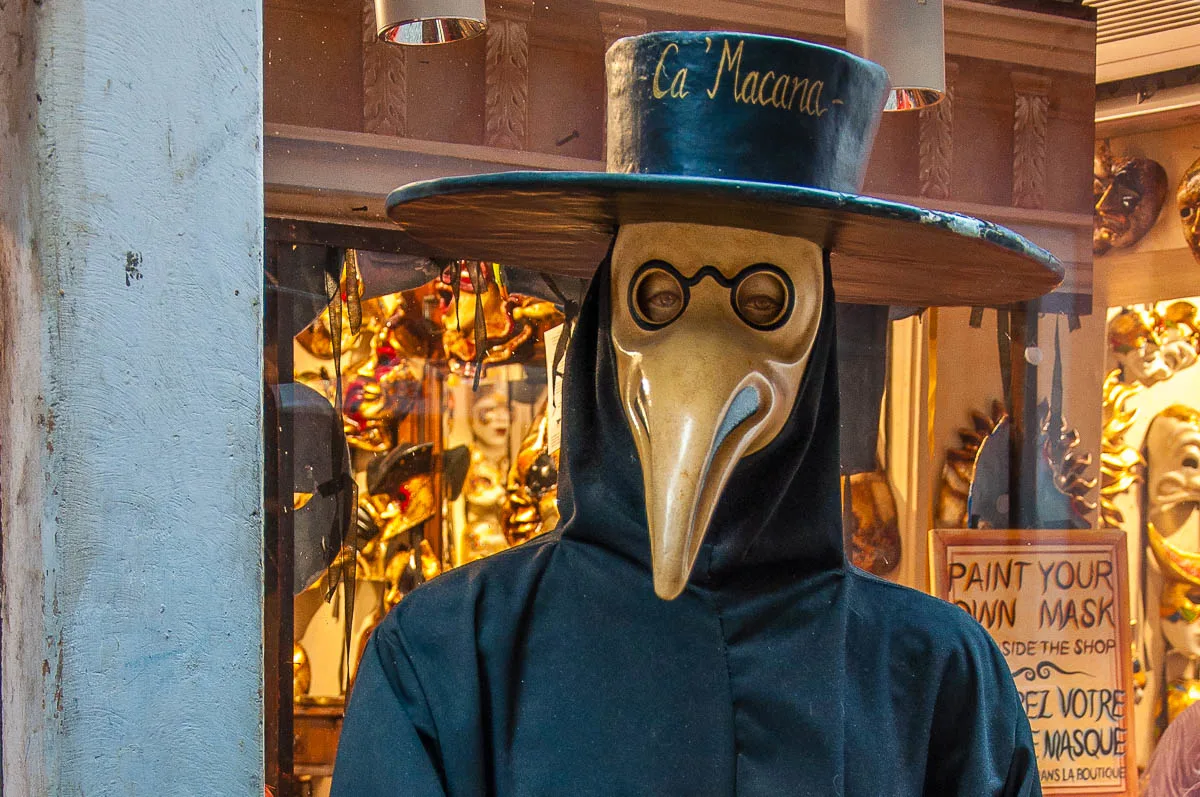
In this blog post, for ease of language, I refer to all artisan masks that nowadays are made in Venice simply as Venetian masks. However, in terms of traditional styles of masks, we need to make a distinction between historical Venetian masks and Commedia dell’Arte masks.
Historical Venetian Masks
These are the styles of Venetian Carnival masks that were worn in the Republic of Venice from the Middle Ages to its fall in 1797. They are ancient in their origins. The first law regulating their wearing dates back to the 13th century but masks were in use in Venice even before then. Some of these historical Venetian masks are:
Bautta (also spelled bauta) – this is the most traditional Venetian Carnival mask. Originally it was worn only by men of all social classes but by the 18th century, it had also been embraced by married women. It consists of several elements:
- volto (or larva) – the actual face mask. Traditionally white it has a long nose and a triangular bottom half that jutts above the lips of the wearer. This allows you to eat and drink with the mask on.
- tabarro – a black cloak.
- zendale – the traditional hood worn over the tabarro and underneath the tricorno.
- tricorno – a tricorn hat.
What I like about this mask is that it changes the pitch of the voice of its wearer making it even harder to guess their identity. Bear in mind that nowadays, the term bautta is often used to refer to just the mask element of the whole original disguise. At the same time, volto nowadays is customarily used to signify a full-face mask that can be simply painted white or beautifully decorated with swirls and other elements.
Moretta (also known as muta) – a black oval mask worn exclusively by women. It was held in place by biting on a button attached to the back of the mask. This prevented the wearer from speaking and thus rendered her mysterious and alluring to the man trying to guess her identity. I find this mask and its implied eroticism rather curious, especially considering that at the time, the ladies of Venice would wear clothes with very deep cleavages. Thus they freely revealed their bosoms but hid their lips and facial expressions behind a small oval mask that sort of made them look like having a black hole instead of a face.
Gnaga – similar to a cat-face, this mask was traditionally worn by homosexual men. Cruelly repressed and persecuted at the time, wearing the gnaga gave them the possibility to be open about who they were but at the same time, the wearer was expected to speak vulgarly and carry around a basket with kittens in it. While we can’t change history and can only learn from it, I have to admit that the story of the gnaga mask always makes me feel rather sad.
Commedia dell’Arte Masks
These are the masks of the characters of the improvisational theatre Commedia dell’Arte. This early form of professional theatre originated in Italy and was very popular between the 16th and the 18th centuries all over Europe.
Each character of Commedia dell’Arte was defined by a particular mask and costume and exhibited stereotyped and highly caricatured behaviour typical for a particular social group. So, for example, here we have Arlecchino (Harlequin) who hails from Bergamo, Il Dottore from Bologna, and Pantalone from Venice to mention but three of the most popular characters.
Nowadays, you will find many Carnival masks inspired by Commedia dell’Arte in the shops of Venice’s artisan mask makers. Particularly popular is the Colombina mask. This is the typical half-face mask that covers the eyes, the top of the cheeks and most of the nose. You can find it plain or lavishly decorated in many different ways.
Plague Doctor Mask
Finally, I need to mention the famous Plague Doctor mask. Nowadays, it is very popular with tourists for its long beak gives it a very macabre look. This mask is different from the ones above in so that it was not a Carnival or a theatrical mask. Instead, it was used to perform a job. In other words, it was worn to make it possible for doctors to approach and treat plague sufferers. If you think that doctors nowadays use personal protection equipment, well, this was the PPE of the Venetian doctors during the 16th century.
The beak was stuffed with aromatic herbs to help the doctor avoid the stench of the disease. The eye holes were covered with an early form of eyeglasses. And the clothing of the doctor was made of waxed canvas which was sealed around the mask thus limiting as best as possible the chances of contagion.
3. Famous Artists Have Depicted Venetian Masks in Celebrated Paintings and Frescoes
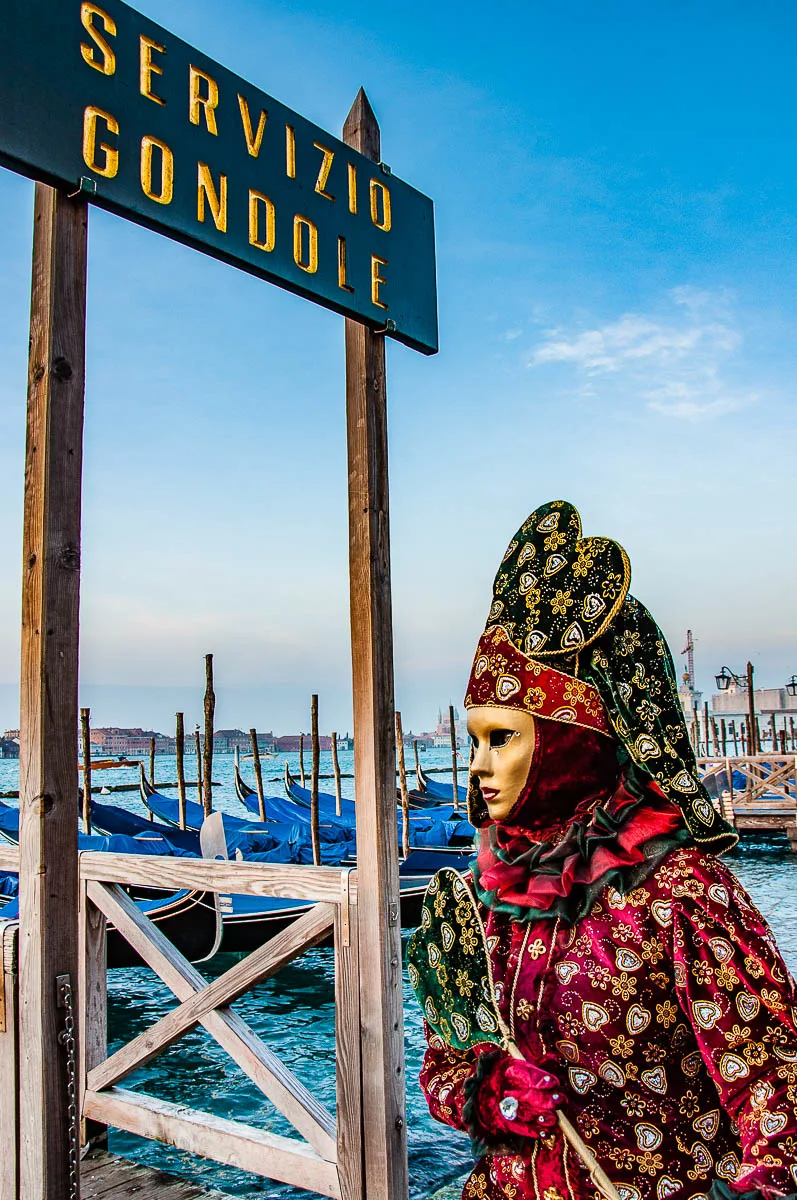
A good way to learn about Venetian masks and to appreciate their role in shaping the culture of the Republic of Venice is to see first-hand their many depictions in the art collections and museums dotted around the city on water.
One of the best places to head to in this regard is Ca’ Rezzonico. This is a magnificent palace on the Grand Canal that houses the Museum of 18th Century Venice. Here you can admire:
- Pietro Longhi’s paintings documenting the Republic of Venice as it was in the last century of its existence. From the point of view of Venetian masks, some of the paintings to pay particular attention to are:
- Conversation between Bautas – where the central figures of a man and a woman wear the traditional Venetian Bauta disguise.
- Il Rinoceronte – showing a Venetian lady with a face concealed by a Moretta mask.
- The Charlatan – with the central male figure wearing a full Bauta disguise whereas the central female figure has removed the mask but has the tricorn hat, the hood, and the cloak still on.
- Il Ridotto (in English, The Foyer) – showing the main room of the gambling house of Palazzo Dandolo. You will notice that almost everyone depicted here wears a mask. A mask had to be worn by everyone frequenting the gambling houses which remained open during the Carnival of Venice. The gambling tables were operated by impoverished Venetian noblemen and they were not required to wear a mask, which is reflected in this painting.
- Giandomenico Tiepolo’s frescoes depicting Punchinello (originally known as Pulcinella in Italian) – one of the most popular characters of Commedia dell’Arte. In the past, these frescoes graced the villa where the painter’s family lived in the small village of Zianigo in the Venetian mainland. They were transferred to Ca’ Rezzonico in 1936 after the city of Venice purchased them to prevent them from being sold abroad.
4. Venetian Masks Continue to Evolve
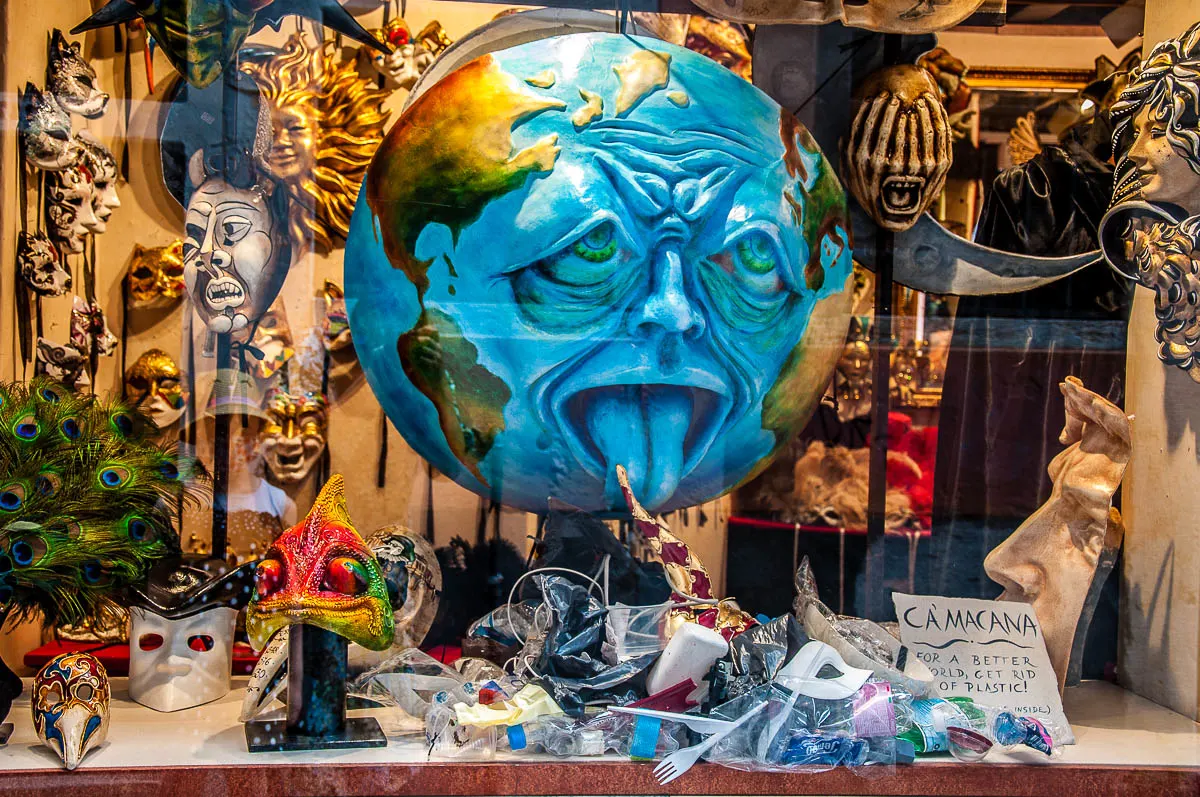
Alongside the historic and traditional Venetian masks, nowadays in Venice, you can see, admire, and purchase many different types of masks which have been inspired by our modern times.
Made of paper mache, leather, and metal, these new designs are very imaginative and appeal to our sense of fun, drama, and grandeur.
The artisan mask makers of Venice seem to be always seeking new inspirations and influences to adapt to the medium of the Venetian mask. From masks studded with crystals to masks covered with gold and silver macrame, from masks lavishly decorated with feathers to masks recreating different animals or even pop culture characters, the Venetian mask is open to creative interpretations.
You just have to have a look around the mask shops of Venice and see which mask will appeal to your sense of glamour and whimsicality. It can be a tiny mask to use as a decorative piece in your home or a huge creation designed to command attention in a large space. It can be a mask for a masquerade ball or a mask that recreates in the most wonderful ways animals, planets, famous works of art, and many other imaginative subjects.
5. Venetian Mask Are Made to Be Worn

Venetian masks look stunning as decorative pieces, especially the larger ones. At the same time, traditionally masks made in Venice are designed to be worn.
The creation of a paper-mache Venetian mask takes several steps. First, the artisan mask maker creates a mould out of clay. Once dry, liquid plaster is then poured into it to create a negative mould – a reverse image of the original design. When the plaster hardens, the clay mould is broken to release the negative mould.
The negative plaster mould is then used to create the actual masks. This is done by layering pieces of paper impregnated with a sticky paste inside the plaster mould. It takes several layers – each pressed and adjusted by hand – to create a mask. Once dry, the mask is removed and decorated accordingly.
The plaster mould can be used many times but if the mask maker wants to create another plaster mould, he needs to sculpt a new clay mould from scratch. Often mask makers have over fifty different styles of masks. Each style requires the execution of the above process.
The masks made to be worn are anatomically correct. This way, they fit well and the wearer quickly gets used to the sensation of having a mask on their face.
If you are buying a Venetian mask to wear for a special occasion, spend a bit of time finding the one that would look truly great on you. See how the different models emphasise your face and how by concealing your features they add mystery. Ask the mask maker for advice and for their permission before you touch and try the masks on.
Once you buy your Venetian mask, wear it for an hour or so before your event. You will notice that you may need to hold your head a bit differently than usual. Your line of vision may also change. You may want to see if you need to apply particular make-up around your eyes to make them more expressive when glimpsed through the eye holes of the mask.
Wearing a Venetian mask is fun! For a moment in time, you can be anyone you want to be and that’s the beauty and magic of it.
6. You Can Create and Decorate Your Own Mask in Venice

To truly experience the history and charm of the Venetian masks, consider attending a Create and Decorate Your Own Mask workshop when you are in Venice. You can choose a mask-making class or a mask-decorating class. Or you can combine them in one workshop. An experienced mask maker will guide you throughout the class revealing to you the secrets of Venetian masks.
In the mask-making class you will create a mask from scratch using moulds and paper-mache. In the mask-decorating class you will choose an already made mask from dozens of different styles and then paint it and embellish it. In both cases, you get to take the finished mask home with you as a wonderful souvenir of your time in Venice.
This type of workshops are organised by all of the best-known artisan mask makers in Venice. Click here, here or here to see the different options/prices and to book your place straightway.
Last summer, I took my child to a Decorate Your Own Mask at Ca’ Macana – a well-known Venetian mask-making studio and shop. It was a lovely experience, especially after the end of the incredibly strict lockdown we had just been trough in Italy.
First, we were shown the different styles of masks available to decorate. There were over fifty different designs – full face, half face, animal-shaped, even moon- and sun-shaped. Then the mask maker explained how to achieve professional results – from mixing the paints to adding swirls and adornments. We could decorate the mask exactly as we wanted.
It was wonderful to spend an hour in the studio surrounded by moulds, masks, paints and feathers. To this day, it is a lovely memory of Venice and our life in Italy.
7. Handmade Artisan Masks in Venice Are Worth Every Penny
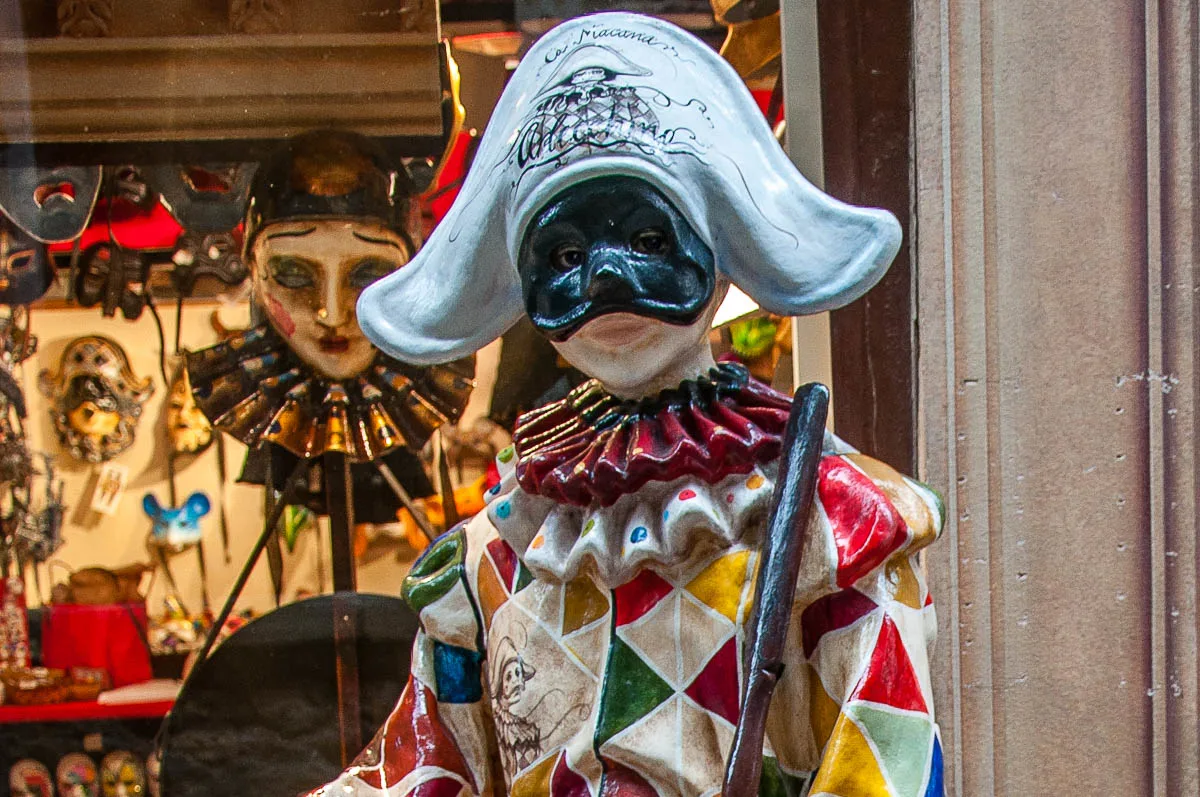
Surrounded by endless shopping opportunities in our modern world, we tend to baulk a bit at the prices of artisan goods. A steady stream of cheaply manufactured products has really spoilt us and we tend to first check the price rather than consider the actual value of things.
At a first glance, the prices of handmade Venetian masks may come across as just a bit too much. You may even want to bargain just a touch. Or even mention that the stalls in Venice’s most touristic hotspots sell masks for a fraction of that.
The thing is that an artisan-made item like a Venetian mask has a lot of work, research, and creativity invested in it.
Venice’s artisan mask-making workshops have spent decades reviving the art of Venetian masks. When mask-wearing was outlawed after Napoleon Bonaparte and Habsburg Austria dissolved the Republic of Venice in 1797, the art and craft of mask-making fell into oblivion.
It was only in the 1970’s and 1980’s with the resurgence of the Carnival of Venice that Venetian masks were put back in the spotlight. Craftsmen and enthusiasts took it upon themselves to research and revive techniques that had been forgotten for two centuries. Since then, the range of masks made and sold in Venice has exponentially grown showing the never-ending artistry of the craftsmen and the adaptability of the medium of the mask.
Techniques from painting, restoration, theatrical stage set design, costume making and even carpet making have been studied and employed.
Venice’s artisan workshops make their masks from start to finish in the city on water itself thus providing employment for people on-site. No machines and no chemicals are used to speed up the production of masks. Only a few simple, hand-held tools are employed here and there. Several of the mask-making tasks are performed entirely by hand.
Rents for retail and studio spaces in Venice tend to be very high. Insurance premiums climb year after year due to the unique location of the city and the threat of destructive levels of acqua alta.
As there are no cars and buses in Venice, everything that needs to be delivered or dispatched arrives and leaves on boats. It then needs to be carried from the edge of the canal to the workshop and vice-versa. It is not an easy life nor an easy way to work. Yet, the artisan mask-making workshops in Venice make an effort every day to continue creating beauty and to keep the traditions of Venetian masks alive.
Considering all this, it’s easy to understand why the prices of handmade Venetian masks are higher than the imported ones sold cheaply on the street stalls. And while each mask-making artisan would stand behind his work and guarantee that it’s made with paints and materials which are suitable to be in close contact with human skin, can the same be said for the cheap imports?
8. Venetian Masks Are Not Difficult to Take Home with You
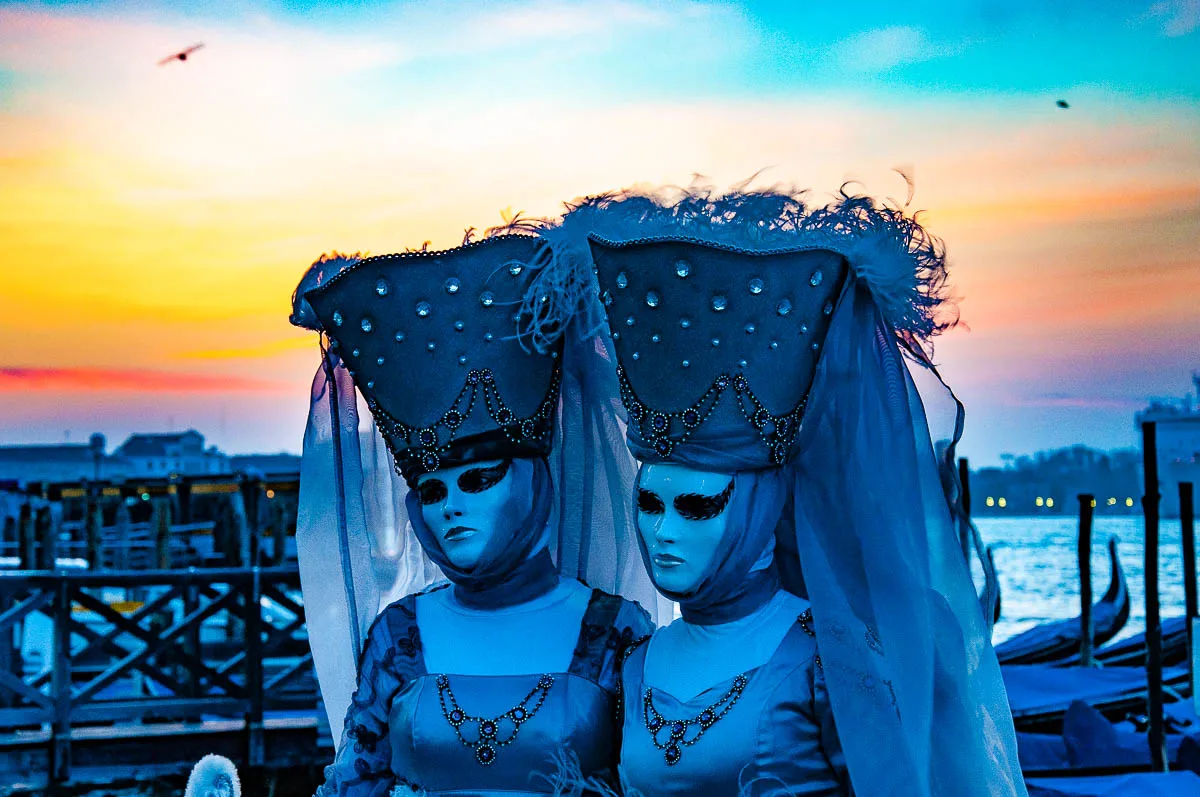
Venetian masks look so lovely and dainty that when you buy one or more, it’s only natural to fret how you are going to take them back home in tip-top shape.
Don’t worry! Artisan-made Venetian masks are sturdy. They are constructed with quality materials and a lot of attention to detail. Just ask the mask maker to wrap your mask well for you. Then, place it carefully in your suitcase using soft layers of rolled clothes and socks to fill in all gaps.
If you prefer to carry the mask in your hand luggage, then make sure in advance that it fits in the allowed size bag and that it can be safely stashed either underneath the front seat or in the overhead lockers of a plane.
Alternatively, you can have the Venetian masks you have bought shipped directly by the shop to your address. This works well if you are buying several masks or a large decorative mask. Just bear in mind that depending on the final destination, you may need to pay customs charges upon receiving the masks by courier or post.
If for whatever reason you don’t want to put your Venetian mask in your luggage or your hand luggage, then you can buy one from the souvenir shops at Venice Marco Polo Airport. Consider this a last resort solution though in case the shops are not open, you don’t find the style mask that you want or you don’t have enough time to shop right before your flight.
In any case, you can always buy authentic Venetian masks from abroad. See point 9 below for suggestions on how to do it.
9. You Can Buy Authentic Venetian Masks from Abroad
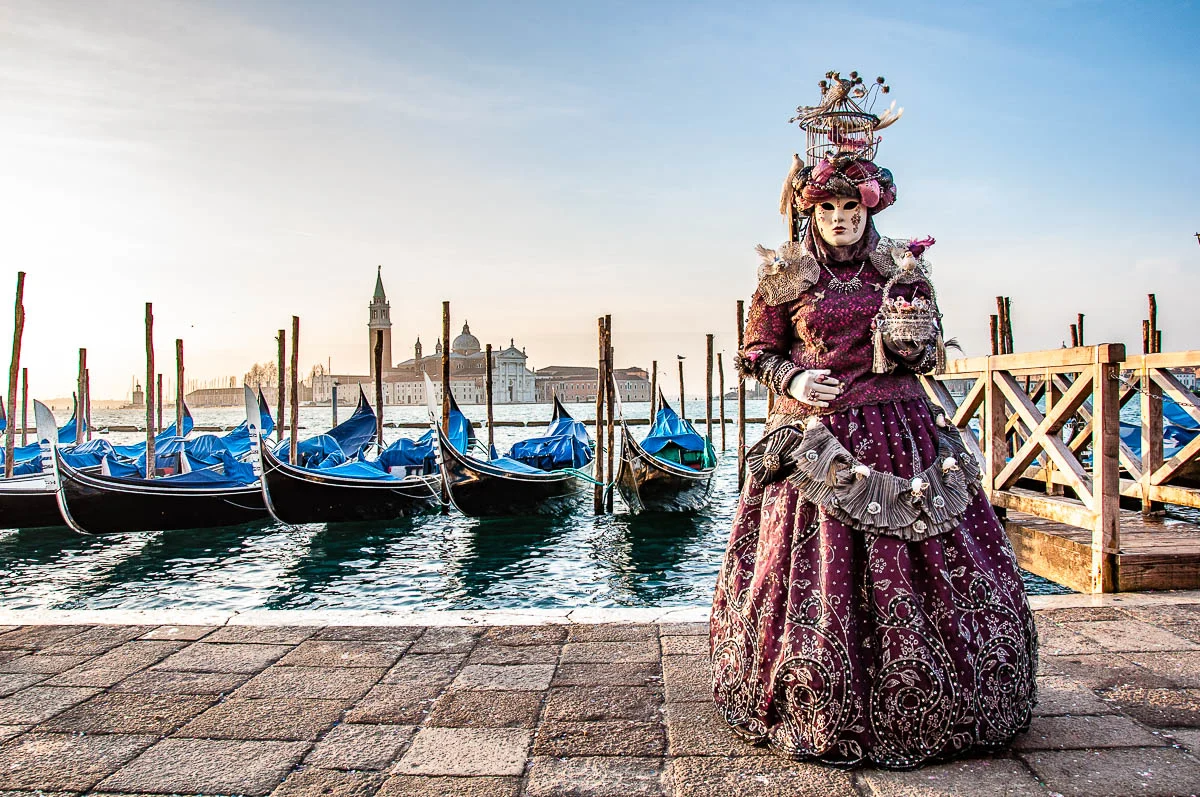
You don’t need to travel to Venice to buy authentic Venetian masks.
While nothing compares to the experience of walking into a Venetian artisan mask shop and choosing your mask from a fabulous display, sometimes it’s not possible, practical or affordable to venture out to Venice just to buy a mask.
Many of Venice’s artisan mask makers sell their creations online. Here are a few websites for you to have a look at if you are curious. As a disclaimer, I need to point out that I am in no way connected to any of these mask-making studios, these are not affiliate links, and I am only sharing them here to give more visibility to true and authentic artisan work.
- Ca’ Macana – a mask maker extraordinaire, this family-run shop has been in business since 1984 and has supplied Venetian masks to many film productions (with Eyes Wide Shut and Fifty Shades of Grey two notable examples).
- Atelier Marega – in addition to handmade masks, here you will also find reproductions of lavish Venetian clothes from the 18th and the 19th centuries.
- Carta Alta – one of the oldest mask-making workshops in Venice, it makes masks both in the traditional Venetian designs and several innovative styles. I was particularly attracted to their gold stucco masks.
10. It’s Easy to Care for Your Venetian Mask

Well-made Venetian masks are sturdy and can be worn for hours at a time without any issues. Yet, an authentic Venetian mask is an artisan product that needs to be treated with love and care to guarantee its beauty and usability for as long as possible.
Venetian masks made of paper mache should be kept away from water and/or any other liquids. While Venetian masks keep their shape incredibly well over the years, they can be damaged by placing them under undue pressure, for example, by inadvertently sitting on one or a falling book landing on it.
If you are travelling or moving house and want to take your Venetian masks with you, wrap them carefully in bubble wrap and place them between soft items (for example, rolled socks or layers of rolled clothes) to keep them safe on the go.
Avoid leaving your Venetian mask exposed to direct sunlight for a long period of time. If you are using your Venetian masks as decorative pieces, dust them every now and then. However, don’t spray them with any liquids and don’t use abrasive detergents. A soft dry cloth or a feather duster is best.
In Conclusion
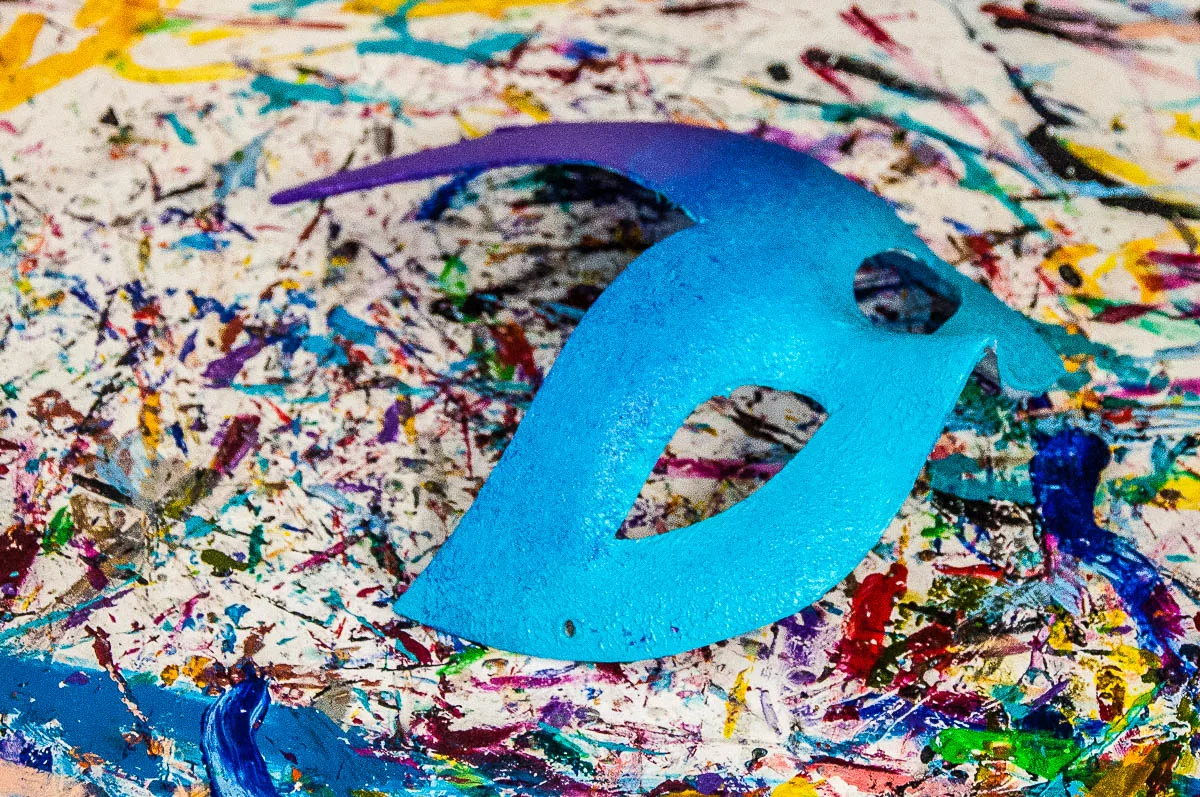
Venetian masks are beautiful and a great souvenir to bring home with you after a visit to Venice.
Made by hand by artisans who keep alive the history and traditions of Venetian masks and the Carnival of Venice, masks are everywhere you look in the city on water. It’s easy to fall in love with them and to want to have at least one.
In this blog post, I share with you ten facts about Venetian masks. From when and how the Venetians started wearing masks to what Venetian masks are made of and how to take care of them, I have included all sorts of curious details.
To show you how glamourous and fabulous Venetian masks can be, I illustrated this blog post with photos I have taken at the Carnival of Venice throughout the years in addition to a few photos taken at Ca’ Macana mask-making studio and shop.
I hope that the information shared above has been of interest and that it will encourage you to delve into the history, traditions, and meaning of Venetian masks.
Enjoy Venice and its masks!
Now get ready quick for your trip to Venice in Italy!
- Consult these guidebooks.
- Book plane tickets to Italy.
- Book train tickets in Italy.
- Rent a car in Italy.
- Research accommodation.
- Pick local tours and activities.
More Helpful Venice Info for You
Venice: Essential Tips, Hidden Gems, Best Airports, Boats in Venice, Haunted Venice, Day Trips from Venice, Arco del Paradiso
More Helpful Italy Info for You
Day Trips in Italy: Venice to Verona, Venice to Milan, Venice to Lake Garda, Bologna to Venice, Florence to Venice, Milan to Venice, Milan to Lake Garda, Verona to Venice, Verona to Milan, Verona to Lake Garda
Best of Italy: Italian Piazzas, Italian Food, Italian Markets, Italian Coffee Culture
Northern Italy: 18 Best Cities to Visit, Major Airports
Lake Garda: Best Towns, Nearest Airports, Travel Options, Lake Garda with Kids, 10 Beautiful Castles
Lake Como: Things to See, Nesso
Lombardy: Best Cities and Towns
Friuli Venezia Giulia: Venzone, Most Beautiful Villages
Emilia Romagna: Bologna, Ravenna, Comacchio, Most Beautiful Villages
Marche: 6 Reasons to Visit, Gradara, Frasassi Caves, Temple of Valadier
Trentino: Best Cities and Towns, 15 Amazing Places, Rovereto, Lakes in Trentino, Lake Caldonazzo, Paneveggio and Pale di San Martino
Veneto: Best Cities to Visit, Top 15 Places, 30 Adventures, 15 Most Colourful Places
Verona: Things to Do in One Day, Verona Opera Festival, Day Trips from Verona
Padua: Things to Do in One Day, 101 Facts About Padua, 10 Reasons to Visit Padua, Day Trips from Padua
Vicenza: Things to Do, Day Trips from Vicenza
Thank you for reading! Please, leave me a comment, pin the images below or use the buttons right at the top and at the end of this blog post to share it on social media.
For more useful information like this, please, like my blog’s page on Facebook and subscribe to my strictly no-spam newsletter.

